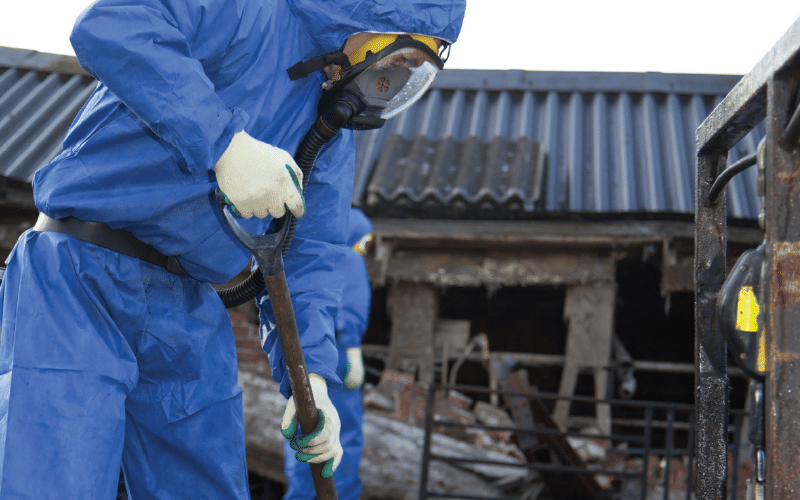ASBESTOS – THE SILENT KILLER

ASBESTOS – THE SILENT KILLER
Asbestos exposure is the main cause of construction workplace fatalities in New Zealand. Asbestos was commonly used as an insulator for buildings from the 1940s through to the 1990s, so anyone who is involved in alterations of buildings built during this period should be on the lookout.
What do we know about asbestos?
- Natural occurring mineral found in the ground
- Excellent durability, fire resistance and insulating properties
- Fibres can be 50 to 200 times thinner than human hair
- Fibres can float in the air for up to 30 days and inhaled into the lungs
- Asbestos fibres are almost impossible to see with the naked eye.
Exposure to asbestos can cause serious health effects if the fibres are inhaled into the lungs
Most of the asbestos fibres enter the body through breathing and end up in our lungs where they remain. After 20 to 50 years they may then develop into cancer. Sadly these types of cancers and diseases listed below are very painful and a person may die quickly after being diagnosed.
- Asbestosis – irreversible scarring that impairs breathing
- Lung cancer
- Mesothelioma – cancer of the linings of the lung
- Non-cancerous diseases that affect the linings around the lung and abdomen
What types of asbestos have been used?
The most common types of asbestos fibres that are likely to have been used in New Zealand are:-
- White – Chrysotile asbestos
- Brown – Amosite asbestos and
- Blue – Crocidolite asbestos
How has asbestos been used in buildings?
There are two main types of material that contain asbestos:
- Friable is loosely bonded asbestos and is potentially very dangerous because it can crumble and release fibres into the air.
- Non – friable is a bonded asbestos and is found a number of building materials, it can become friable if it is weathered or damaged.
Let’s have a closer look at where you mainly find these types of asbestos:
Friable asbestos was commonly used as lagging rope on water pipes, around the doors of old domestic heaters and inside fire places. Other uses have included the manufacturing of sheet vinyl flooring as backing and as loose insulation in a roof.
[one_third][/one_third][one_third][/one_third][one_third_last][/one_third_last]
Asbestos was used in many products such as Hardiplank and textured ceilings. Other common uses were with roofing sheeting and guttering, various types of external wall cladding and Zelemite boards on switchboards. Here are some examples:
[one_third][/one_third][one_third][/one_third][one_third_last][/one_third_last]
[one_third][/one_third][one_third][/one_third][one_third_last][/one_third_last]
[one_third][/one_third][one_third][/one_third][one_third_last][/one_third_last]
[one_third][/one_third][one_third][/one_third][one_third_last][/one_third_last]
[one_third][/one_third][one_third][/one_third][one_third_last][/one_third_last]
What is the likelihood of finding asbestos?
As a general rule, if a building was built:-
Table goes here
When is asbestos is dangerous
If the building contains asbestos products that are in good condition and is undamaged, then leave it alone – ‘let sleeping dogs lie’. Asbestos only becomes dangerous when it has been disturbed or damaged resulting in the release of the fibres that can then be inhaled.
If you do find asbestos follow this advice… and don’t:-
- Cut it
- Drill it
- Saw it
- Sand it
- Scrape it
- Dismantle it
- Scrub it
- Water blast it
- Demolish it
- What ever you do don’t dump it
What do I do if I find asbestos in the building I am working in?
- Post warning signs
- Stop all work activities and contact WorkSafe NZ for advice.
- You can access a list of certified removers from the WorkSafe NZ website www.worksafe.govt.nz
- Avoid creating airborne DUST
- Everyone on site must wear appropriate Respiratory Protection Equipment (RPE) as defined in the Australian/New Zealand Standard 1716:2012:
- P2 half mask disposable or with cartridge filter, for use with undamaged or asbestos in poor condition
- P3 full face piece with cartridge filter is the minimum when carrying out maintenance work.
- Face fitting Respiratory Protection Equipment (RPE) must be fitted correctly to be effective. Anyone with facial hair may need to remove it or consider a full-face supplied-air respirator to ensure there is a tight fit between their skin and the sides of the mask being worn.
Ensure that everyone on site has been trained in how to fit and wear the correct respiratory mask so that it functions effectively – remember that asbestos fibres are very small and are very difficult to see with the human eye.
The removal of asbestos is a notifiable piece of work
In the event that the asbestos must be removed from a worksite, prior to the removal work starting you need to notify WorkSafe NZ to confirm restricted work is required and an inspection may be needed. The persons performing the removal work must hold a ‘Certificate of Competence’. You can find a nationwide list of certified asbestos removers from the WorkSafe NZ web site www.worksafe.govt.nz.
You will also need to make sure that all personnel on site follow the required procedures which include monitoring and documenting all asbestos related activities – there are no short cuts with asbestos. If in doubt please contact WorkSafe NZ for advice and refer to: New Zealand guidelines for the management and removal of Asbestos.
These guidelines are produced by the New Zealand Demolition and Asbestos Association (NZDAA) and contain the industry’s current best practice standards and procedures for the safe and efficient removal, transportation and disposal of asbestos – contaminated material. You can find the guidelines (HTML only) on WorkSafe website www.worksafe.govt.nz.
Copies of the guideline can be purchased from www.demolition-asbestos.co.nz